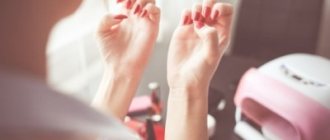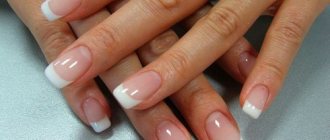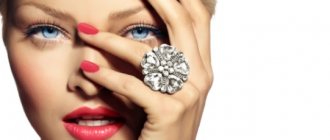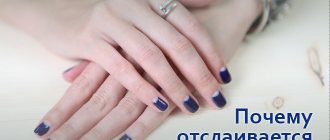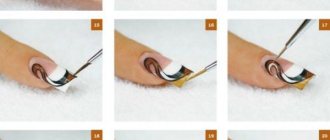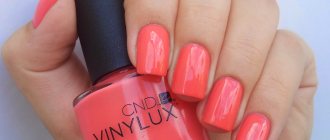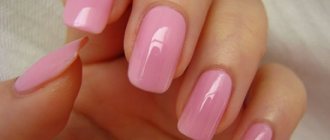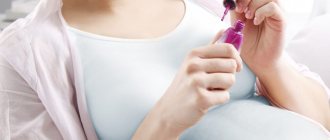Gel polish during pregnancy will not harm if the woman feels well and does her manicure in compliance with safety rules.
You cannot use formulations with formaldehyde, toluene, camphor, or butylated hydroxyanisole. Otherwise, there is a risk of increased toxicosis, miscarriage, and fetal malformations. You should also not paint your nails with gel polish in the first and last trimesters.
Gel polish during pregnancy: pros and cons
Gel polish is not prohibited during pregnancy, but it can cause inconvenience or even health problems:
- At the very beginning. At this point, there is no placenta, and there is a possibility of toxic substances reaching the fetus that can interfere with its proper development. Odors from the liquids used increase toxicosis.
- In the third trimester. The coating can prevent you from correctly assessing the condition of a pregnant woman, because problems are first signaled by nails changing their shade.
What could be the threat in the early stages, in the first trimester?

In the early stages, that is, in the first trimester, gel polish coating may be undesirable for several reasons:
- During this period, the placenta has not yet formed. And theoretically, toxic elements present in the base, varnish, and primer can penetrate to the fetus. This occurs through the mucous membranes and skin of the expectant mother. Toxic substances can disrupt fetal development.
- In the first weeks, many women suffer from toxicosis. And smells that were previously unnoticed are felt very acutely. Going for a manicure can cause nausea, dizziness, and fainting.
- Hormonal changes, inevitable during this period, often lead to a deterioration in the condition of the nails. They become thinner, flake off, and the coating can completely “finish off” them.
- The same reason as in the previous case aggravates all sensations. Removing the old coating, manipulations necessary for hygienic manicure, polymerization can become unpleasant and painful. And this is harmful not only to the pregnant woman, but also to the fetus.
In the third trimester
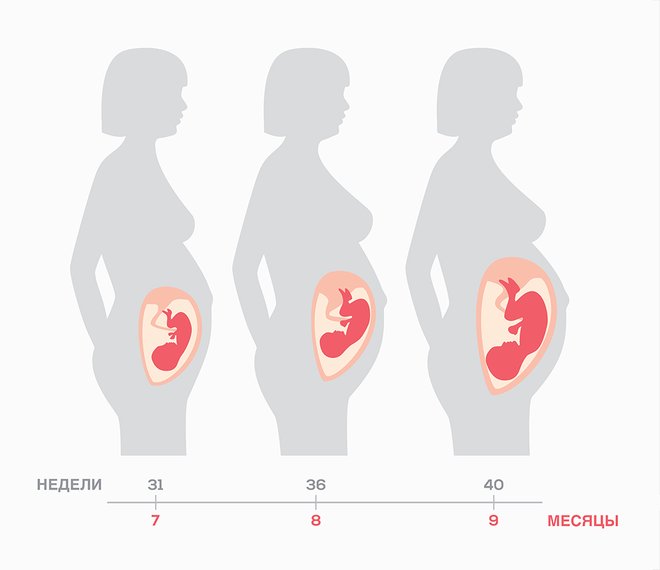
The third trimester is the time of approaching labor, which can occur with complications. To monitor the condition of the expectant mother, you also need clean nail plates. Based on their color, a specialist can quickly determine that it is not in order and prescribe tests and treatment.
When admitted to the hospital for preservation, the nails must also be clean, because the woman’s pulse will be measured, and the coating will prevent getting correct data. This is also important before childbirth for diagnostics and monitoring of the woman’s condition.
In addition, the child may request to be born earlier than expected, and it is difficult to remove the covering on your own.
general information
During pregnancy, it is recommended to use nail polish for manicure that does not contain a substance such as formaldehyde. It is also advisable to select products that do not contain camphor and toluene. These components have a toxic effect on the body that can affect the condition and development of the fetus.
Formaldehyde and other substances can provoke a negative reaction in the mother’s body:
- headache;
- nausea;
- increased heart rate;
- increased blood pressure;
- and others.
There are also risks of developing pathologies and reducing immunity in the fetus. This is due to the effect of chemicals on the nervous system.
Each component has side effects that you should be wary of during pregnancy.

- Formaldehyde. Improves the connection of the product with the nail plate. Its pungent smell causes dizziness and nausea.
- Toluene. Necessary for air drying. Penetrating through the mucous membrane of the respiratory tract, it has a carcinogenic effect.
- Camphor (essential oil). Gives shine and a certain consistency to the coating. Can cause uterine tone.
Before purchasing (using) nail polish during pregnancy, you must carefully study the composition of the product. Rare use of conventional varnish coatings does not cause significant harm to the body, but with frequent use, care should be taken to ensure the safety of the health of the mother and child.
Recommendations for manicure
In order to reduce the possible negative impact of manicure products, you should follow several rules during pregnancy. These recommendations are given by specialists who have experience in manicure and know what side effects nail polish can cause.
- Do not use nail polish more than once a week.
- Before applying the product, apply a base coat to the nail plates.
- It is not advisable to use aggressive colors (red, black, etc.).
- The room should be ventilated before and after the procedure. If possible, it is better to open the windows or turn on the air conditioning.
- Removing varnish should be done with a product that does not contain acetone.
- After removing the coating, you should use nail oils.
Of course, the ideal option would be to completely avoid using nail polishes during pregnancy. But not every woman agrees to exclude the possibility of having a beautiful manicure. Even if the expectant mother uses nail polish, she should choose a special product, or try to paint her nails only on rare occasions. In this way, it will be possible to avoid the possibility of developing side effects of the cosmetic product.

Negative consequences of covering nails with gel polish during pregnancy
If you paint your nails with gel polish during pregnancy, ignoring safety precautions, there is a possibility of unpleasant consequences:
- Deterioration of health to the point of nausea, dizziness, feeling of lack of air, vomiting, fainting. Therefore, you should only visit offices or salons with good exhaust hood and not make complex designs that require a lot of fuss. It is important to find out the composition of the products used.
- Problems with pregnancy itself, that is, the occurrence of edema, the threat of miscarriage. This is possible if a woman doesn’t feel well, but goes for a manicure and sits there for more than one hour, almost without changing her position. The same threats arise when using low-quality products.
- Allergies in a woman, and then in a baby. The first is possible because immunity decreases during pregnancy. And drugs that previously did not cause a reaction become intolerable. A child may become allergic due to the fact that the mother applied the coating too often and breathed in harmful fumes.
- Deterioration in the quality of nails. If they become dry and brittle, but the woman stubbornly applies gel polish, the plates will become even weaker. After all, the procedure has to be repeated more often. And to ensure that the coating lasts, they also use additional, rather aggressive agents.
- Development of infection. This happens when you get cuts during a manicure and use unsterilized instruments. During pregnancy, this is dangerous because you have to be treated with caution, because many drugs are prohibited.
Developmental defects in a child are also possible. There is a risk if the expectant mother makes a coating using low-quality varnishes and other products that contain toxic compounds.
Nail extensions during pregnancy
Not all women can boast of strong nails of beautiful length. And during pregnancy, there’s just one disorder: nails peel, become thinner, and break easily. In this case, you can resort to nail extensions.
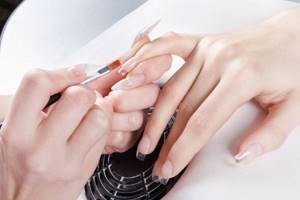
Nail extension (modelling) is the process of artificially increasing the length of a nail or changing its shape.
Nail extension is the modeling of an artificial nail on a natural nail of the desired length and shape using special materials. Three materials are used for extensions:
- gel is a polymer, has a liquid consistency, polymerizes using UV rays in a lamp;
- acrylic - a powder for which a special solution is used, polymerizes immediately in air, the use of a lamp for hardening is not necessary;
- biogel is a modeling gel on a natural basis with plant components, most often used not for extensions, but for strengthening one’s own nails.
The extension procedure is very traumatic. The master has to remove a fairly large layer of the nail during filing and preparation for the procedure. During filing, there is a risk of injury to the delicate skin of the fingers, which can lead to infection.
Extended nails, like gel polish, may not last well in pregnant women. Much in this matter is determined by the individual characteristics of the body. Therefore, if the procedure is not suitable for you, refuse it until the birth of the child. After all, well-groomed nails are just a neat manicure, even without a colored coating.
Video: nail extension procedure
Pros and cons of extension techniques
Gel and acrylic are artificial materials. They contain the “toxic troika”, which has already been mentioned. Acrylic also has a strong unpleasant odor. By the way, he came to manicure from dentistry, so his smell evokes certain associations.
Why does gel polish not last during pregnancy?
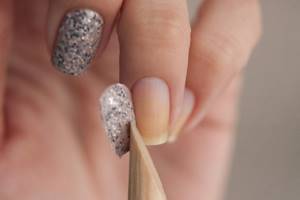
For many women, gel polish does not last during pregnancy due to hormonal changes in the body. They can lead, for example, to hyperhidrosis. Your hands become wetter and your nails too, which means the coating comes off faster.
Sometimes the plates themselves change structure, becoming more fragile. In other cases, there are no external signs of deterioration in their condition, but the manicure does not last long. These are also hormones.
In case of such problems, you need to look for more reliable means for performing coverage or abandon it.
Contraindications for pregnant women
A manicure using shellac is not suitable for all pregnant women. Contraindications to the procedure:

- fungal nail infections;
- injuries or severe delamination of the nail plates;
- allergy to individual coating components;
- taking antibiotics.
If a woman has no contraindications, applying gel polish is allowed. Doctors emphasize that it does not cause obvious harm to expectant mothers.
Safe Procedure Rules
For a manicure to bring joy and not health problems, you should:
- do it in a good salon, where there are windows that open, an extractor hood, a vacuum cleaner, tools are sterilized, and high-quality products are used;
- visit the specialist only if you feel well, and if you feel unwell, stop the procedure;
- do not tolerate if you feel a burning sensation when drying in the lamp;
- Apply sunscreen to your hands, but understand that the design may not last as long;
- Before removing the old covering, put on a mask to minimize dust inhalation;
- take breaks from using gel polish to monitor the condition of your nails.
Removing shellac
Gel polish itself does not harm the nails. The most common reason why the condition of nails deteriorates is improper removal. There are two ways to remove gel polish:
- dissolve with liquid;
- cut with a milling cutter.
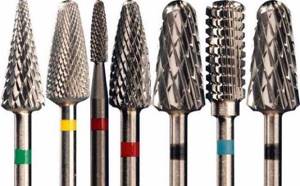
With modern hardware removal of the coating, the polymer colored layers are cut off with a cutter, leaving the base. Thus, neither the file nor the colored varnishes affect the entire nail. It is better to avoid classical removal with solvents, because the liquid, softening the polymer, affects both the nail, constantly softening it, and the skin, drying it out.
At home, you can carefully cut off the coating with a nail file. It is best to choose an abrasiveness of 180 grit; it is written on the files themselves - this is both a hard and safe surface for nails.
Self-removal with ordinary acetone can be injurious - this is too weak a solvent, which will soften the varnish, and with it the nail, for a very long time, and will also dry out the skin.
If the situation is hopeless and it is impossible to cut off the varnish (there are no tools), use a professional liquid. The glossy layer of varnish is removed with a nail file, then you need to apply cotton wool or a sponge soaked in the product and secure it with foil. Wait according to the instructions on the jar, remove the softened material with an orange stick.
What do doctors think?
Doctors do not prohibit manicure with gel polish during pregnancy. You just have to give it up in the first trimester, when the body adapts to the new state, and closer to childbirth. The rest of the time, coverage is acceptable provided the pregnancy is normal, you are feeling well and quality materials are used.
A beautiful manicure is a positive emotion that is so necessary for an expectant mother. But it should not interfere with maintaining health. If everything is not all right with him, the procedure should be postponed until better times or simplified as much as possible.
Allergy to shellac
Unfortunately, you may be allergic to some components of the varnish. If after the procedure there is a burning sensation, redness, or peeling of the skin, the material should be removed immediately. You cannot take allergy medications on your own during pregnancy, only as prescribed by doctors.

A properly furnished and zoned manicurist’s office is a guarantee of a safe procedure even during pregnancy
It is important to get tested and find out the causes of your allergies. It may turn out that the reaction is not caused by the components of the varnish, but by caring or preparatory agents. Then the procedure can be done excluding allergens.
Thus, pregnant women can apply nail polish, but it is important to ensure compliance with all safety rules and technology, choose high-quality cosmetics and avoid popular mistakes. The main thing is to monitor your health and, in case of any unwanted reactions, remove the coating and allow the nail plate to grow.
Don't forget about certificates and medical records
Whatever you choose for yourself during pregnancy - salon care, or home treatments, or maybe both, remember: neither a regular manicure, nor shellac, nor any other nail polishes pose a health hazard mother and baby. The danger lies only in the unprofessionalism of the master you choose. By contacting a specialist, you can be sure of the sterility of manicure instruments and the quality of the materials used.
To be sure that all the materials your manicurist uses fully comply with modern quality standards, do not hesitate to ask about the relevant certificates. Every master in a beauty salon must have a medical book. Ask, be interested, don’t be afraid to offend with an awkward question. Your health and the health of your child is above all.
Which nail polish remover to choose if you are pregnant
When caring for nails, nail polish removers are also used. What to do with them? Of course, acetone is the best way to remove nail polish, but it is the most harmful not only for the nails of a pregnant woman. Acetone is a fairly strong solvent with a distinct, specific odor that can have a toxic effect on the central nervous system. It dries out the nail excessively, washing away the fatty protective film. In turn, this causes overdrying of the nail and, as a result, increased fragility.
What to do? Nowadays, the cosmetics industry produces various non-acetone nail polish removers: liquids, milk, wipes, etc. Moreover, many of them are enriched with vitamin complexes, calcium and creatine, which strengthen nails.
Nail problems (fungus, breaking, peeling, etc.)
For the most part, nails become better during pregnancy than before, as does hair. However, a completely opposite picture can also be observed: nails become more brittle and soft, become covered with spots or grooves, and sometimes peel. This may be evidence not only of hormone surges, but also of a lack of vitamins and microelements spent on fetal growth and metabolic disorders.
The first thing to do here is to reconsider your diet: add more vegetables and fruits, fermented milk products and fatty fish, drink more fluids. Talk to your doctor about which vitamins you should take. Usually, most pregnant women are prescribed whole vitamin complexes, but nutritionists tend to believe that consuming individual vitamins is healthier. It is also worth paying attention to which foods promote the absorption of which vitamins.
If fungus appears on your nails, do not rush to buy medicine. All of them should be used only under the supervision of your doctor. For example, laser therapy or antifungals such as fucorcin are contraindicated during pregnancy. To treat fungus, more gentle methods are used: drops, ointments or medical varnishes.
How to reduce hazardous exposure?
Even if you went through your entire pregnancy with painted nails, a good obstetrician will recommend not doing a manicure and removing the already applied coating before going to the maternity hospital, or better yet, a few days before the PDR.

No one will force him to do the laundry on the spot, but the maternity hospital is a sterile place, with strict laws that must be followed for the safety of your own child, so it is better not to resist.
The condition of even a completely healthy woman who is expecting a child can unexpectedly worsen: surgical intervention or resuscitation procedures will be required.
Painted nails can interfere with the correct reading of information through the sensors attached to them, and can injure a newborn or genitals during cleaning after childbirth. A baby can inhale tiny particles of chipped varnish, and this is very dangerous. No one will be able to appreciate your wonderful manicure in the maternity hospital, and the risk to the health of a defenseless little person is great.
Rules for safe manicure during pregnancy
- Apply varnish in a well-ventilated area.
- Sterilize instruments thoroughly.
- Study the composition of the cosmetic products you use. It is advisable to purchase products marked “5-free”, “4-free” or “3-free”.
- If you feel unwell during a manicure, stop the procedure immediately.
- If you have any doubts or questions, consult a doctor monitoring your pregnancy.
If there is even the slightest damage to the skin on your hands, avoid using cosmetics for your nails. Penetrating into the circulatory system, harmful components will increase exposure.
Tips for caring for the hands of an expectant mother
- Either refuse extensions, or do them in compliance with all the precautions described in our article on nail extensions for pregnant women.
- Pay attention to proper nutrition, eat foods rich in calcium and vitamins A and E.
- Do not grow long nails; bacteria invisible to the eye can accumulate under them.
- Wash your hands often, refrain from visiting the sauna and swimming pool.
- When working with household chemicals, wear gloves.
- To avoid injury to the skin and cuticles, give preference to an unedged European manicure.
- Moisturize and nourish the nail plate using home remedies: oils, sea salt and iodine baths.
What components can cause harm?
The composition of manicure products depends on the manufacturer, cost and many other factors. There are gentle varnishes that contain fewer chemicals.
However, any product contains toxic substances that can cause disruptions in the body at any stage of pregnancy.
These include:
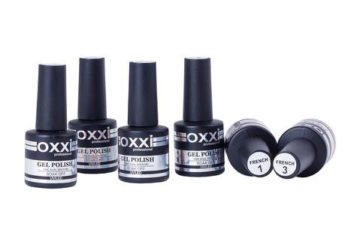
- Formaldehyde . The component helps increase the shelf life of the product, which is why it is considered a harmful preservative. In large quantities it can cause destruction of the plate and the occurrence of allergic reactions.
- Toluene . The substance has a negative effect on the nervous system of a pregnant woman, causing headaches, fatigue, and nausea.
- Dibutyl phthalate . The element negatively affects the functioning of the respiratory system and the condition of the skin.
To create a safe coating, you must contact trusted beauty salons that use high-quality materials for manicure.
Choice of coverage
Modern industry produces a variety of products for manicure and pedicure - from varnishes and rubs to solvents and bases. Not all of them are available and harmless for pregnant women. We rarely look at the composition of a polish, buying a bottle mainly based on the color or price we like. Meanwhile, many varnishes contain harmful substances that can cause allergies in you and your baby.
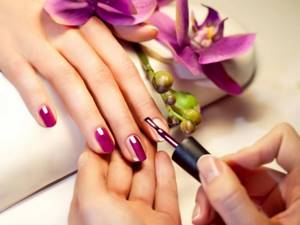
Choice of coverage


